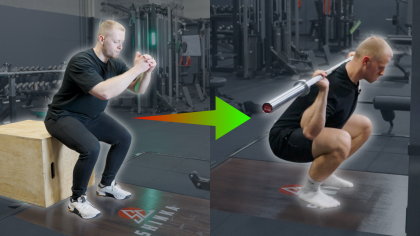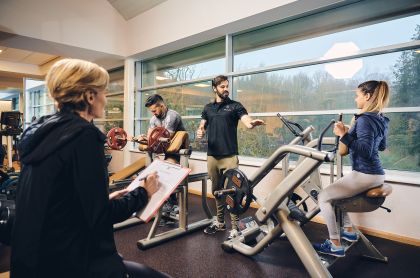✔ EREPS & NASM™ Certified | 💪 + 4000 Personal Trainers trained | 🌍 Internationally recognised diploma | 📞 Need help ?
Whether you're a competitive runner, or you simply run for enjoyment and exercise, your training plan is likely centered around one activity: running. But what if I told you that adding strength training to your routine could help you improve your running technique, lower your risk of injury, and improve your running speed?
I have great news for you: Strength training can do all of those things, and it's simple to incorporate into your current training plan.
THE BENEFITS OF STRENGTH TRAINING
Strength training, or resistance training, isn't only for bodybuilders and gym rats. There are many health benefits to strength training, like improved blood glucose levels, lowered blood pressure, stronger bones, and decreased risk of chronic disease (Winett & Carpinelli 2002). Specific to running, here are some other notable benefits of strength training:
- Lower risk of falling. A well-programmed strength training routine will incorporate exercises that help improve your coordination and balance which can help prevent falls while you're out on your run or living your daily life.
- Improved body composition. Strength training promotes the increase of lean muscle mass which gives your resting metabolic rate a boost. This means that you burn more calories overall, which can help with fat loss to keep you a lean, mean running machine.
- Improves overall movement. When used in tandem with flexibility training, strength training can help to strengthen underactive muscles to help improve movement. This is crucial for runners to help to prevent injuries caused by faulty movement and to help improve running time by allowing all muscles to fire at maximum capacity at the right time. The NASM Corrective Exercise Specialization is a great tool for fitness professionals who want to hone their skills in this arena.
- Improves joint stability. Strengthening the muscles around your joints will help to keep the joints stable, strong, and in good alignment for optimal movement.
- Improves muscular strength, endurance, and power. Each of these elements is vital in running performance, and strength training can help you perform at your best.
- Reduced risk of injury. Nearly 80% of running injuries are related to overuse (van der Warp et. al. 2015). By incorporating strength training that uses new movement patterns and corrects movement imbalances, you can decrease your risk of injury.
WAYS TO ADD STRENGTH TRAINING TO YOUR ROUTINE (UPPER, LOWER)
The current U.S. physical activity guidelines suggest 2 days a week of full-body muscle strengthening. Additionally, research shows that only two 15–20-minute strength training sessions a week are enough to reap these benefits.
Incorporating strength training into your current training plan doesn't have to be complicated, but it should be thought through. The NASM OPT™ Model makes it simple to plan a structured strength training program to help you reach your goals safely and efficiently.
For best results, runners should start in Phase 1: Stabilization Endurance for 4-6 weeks, then progress to Phase 2: Strength Endurance for 4-6 weeks, and then finally Phase 5: Power for 2-4 weeks. Following this progression will help you correct muscle imbalances, improve overall movement, and increase muscular strength and power.
- When Should You Train? There are a few factors to consider when choosing your timing: Training for an event. If you're training for a competition: the closer you are to your event, the lower the intensity should be in your strength training program.
- Days of the Week. The goal is to train twice a week for at least 15-20 minutes. Take a look at your current running schedule. If you're training for a longer race, like a half marathon or a marathon, it's best to keep complete rest days after your long runs. Strength training can be done on the same day as a shorter run as long as you keep the intensity low during the session and avoid lifting to fatigue.
- Consider Recovery Time. In general, pay attention to how well your body is recovering after strength training sessions and adjust the intensity of the workout or the rest time as needed. You don't want to be overly sore or tired as a result of pushing too hard.
- What Should You Train? Basic human movement patterns. You'll want to incorporate the following movement patterns in your weekly routine: push, pull, squat, lunge, hinge, and rotation. Incorporate movements that have you step to the side, like a side lunge, to train planes of motion that are different from running. This way you'll have a very well-rounded program that will help you run better and prevent injury.
- Full Body Sessions. The first way to program your workouts is by incorporating 2 full-body sessions per week. Circuits are the most time-efficient option since you can transition from one exercise to the next with little to no rest.
- Upper/Lower Split. Another option is to train the upper body one day and the lower body the next. For example, a day or two after your long run you could train your upper body while you're still recovering, and two days later train your lower body to give your legs some rest.
With running, you progressively build up your mileage as your body adapts. Strength training is the same way. By starting in Phase 1 and building from there, you'll reduce your risk of injury and begin to the benefits that strength training yields.
WILL STRENGTH TRAINING MAKE ME BULKY? SLOW?
You may have wondered if strength training will slow you down or cause you to bulk up. The good news is that it's possible to lift weights without bulking up. Runners can rest assured that lifting a couple of days a week following the recommendations above is not likely to put on excessive muscle mass. Following a consistent resistance training program is more likely to make you leaner and run faster – win!
SUMMARY
Strength training is an important part of a runner's training regime. In addition to the many health benefits of strength training, it can also help to improve your running time, decrease your risk of injury, and it can improve your running technique. If you don't currently perform strength training, consider adding it to your repertoire of movements to level up your running this year.
REFERENCES
van der Worp, M. P., ten Haaf, D. S., van Cingel, R., de Wijer, A., Nijhuis-van der Sanden, M. W., & Staal, J. B. (2015). Injuries in runners; a systematic review on risk factors and sex differences. PloS one, 10(2), e0114937. https://doi.org/10.1371/journal.pone.0114937
Winett, R. A. & Carpinelli,R.N. (2001). Potential health-related benefits of resistance training. Preventive Medicine, 33(5), 503-513. https://doi.org/10.1006/pmed.2001.0909.



